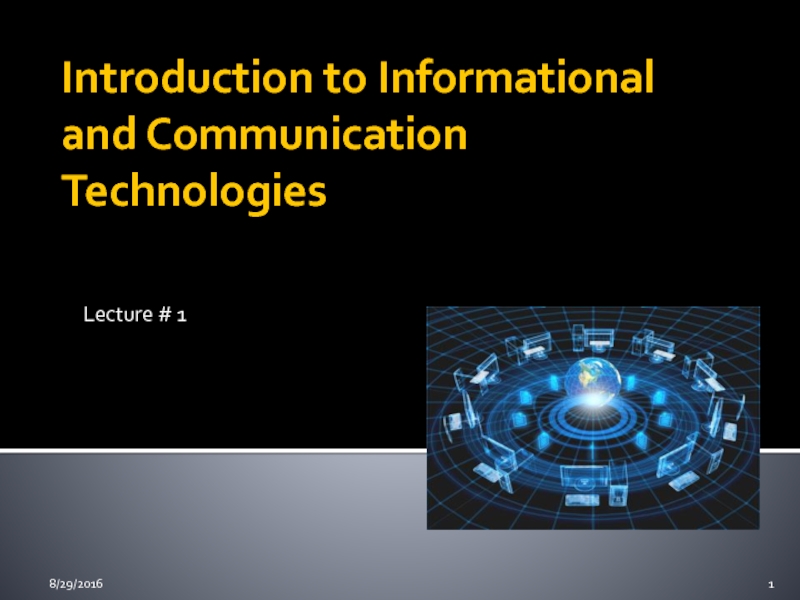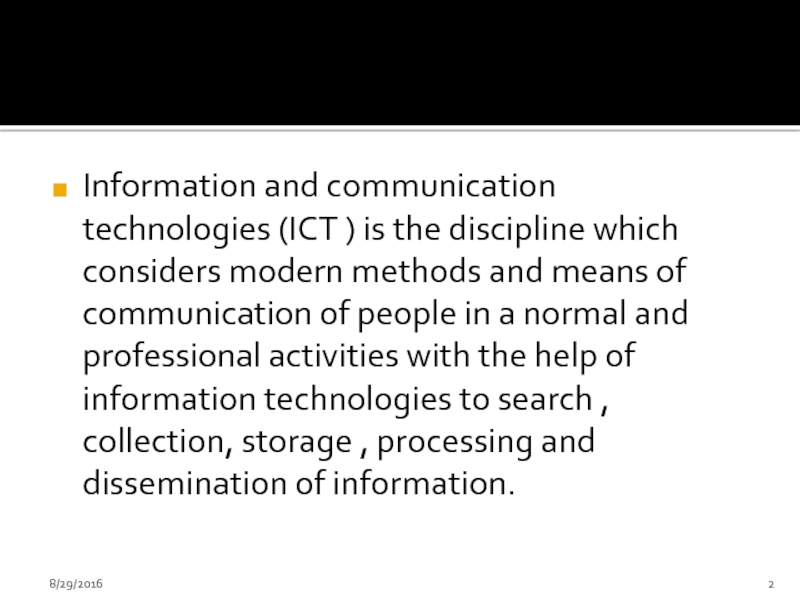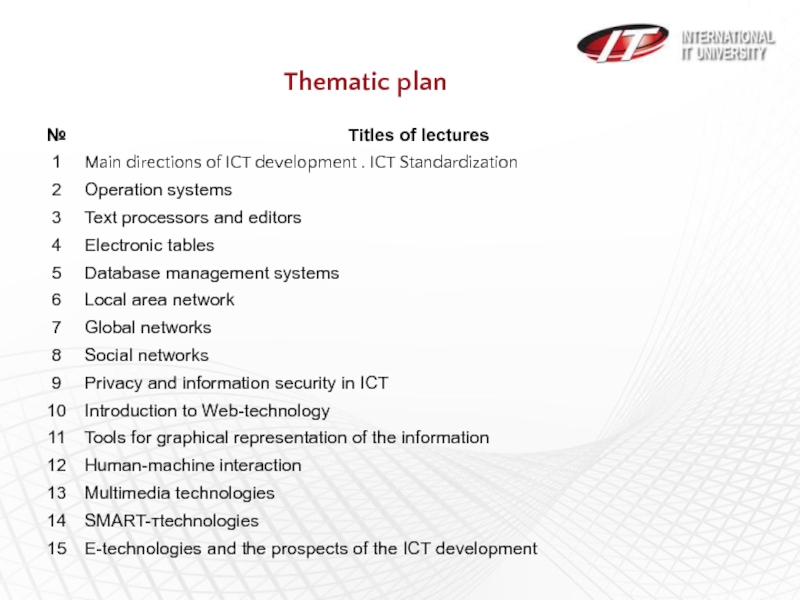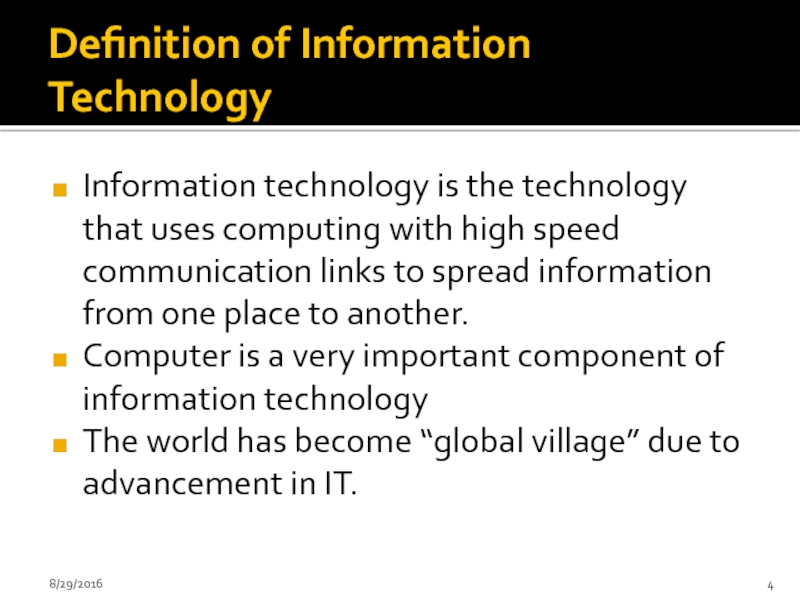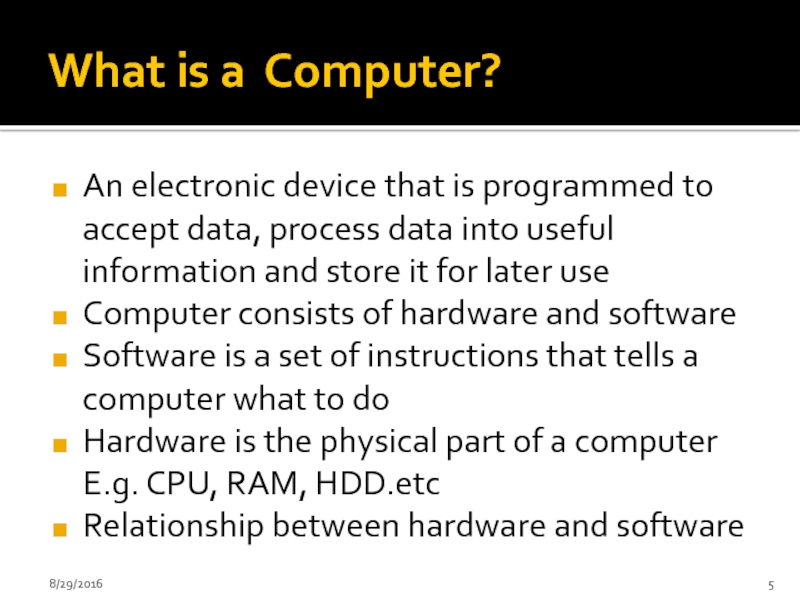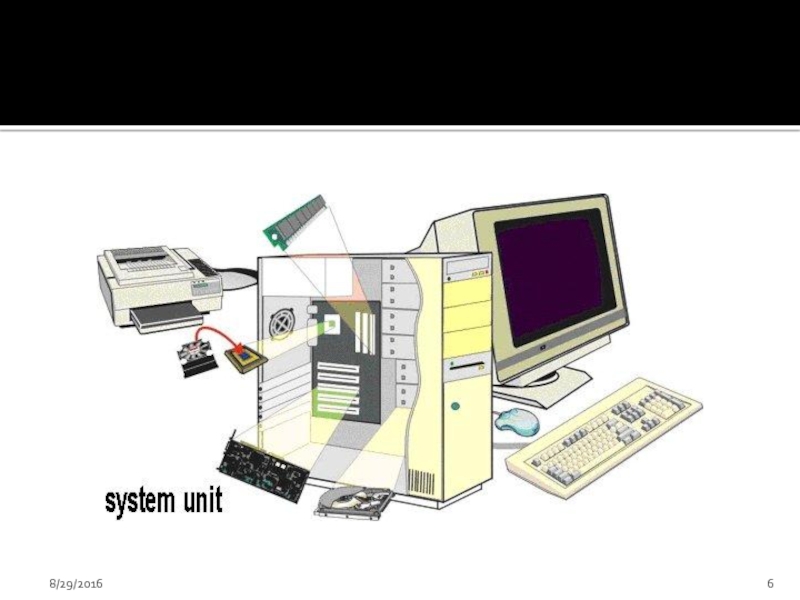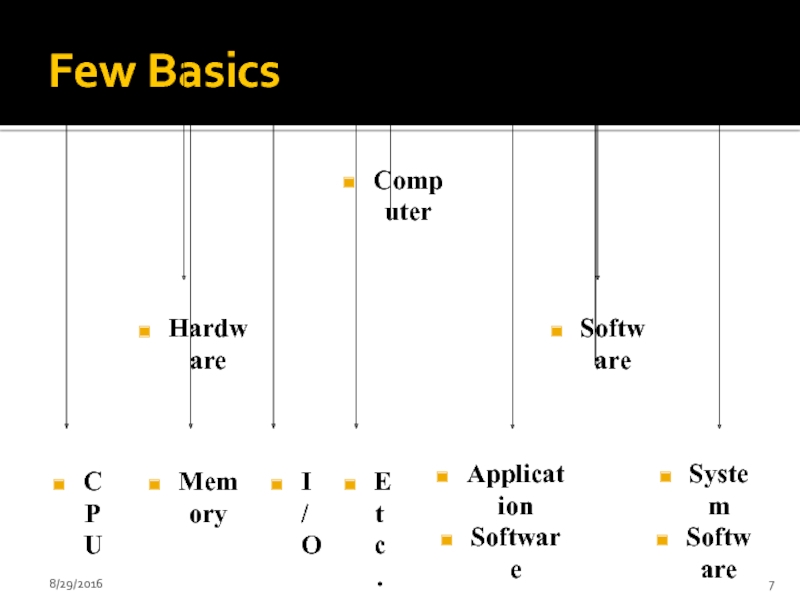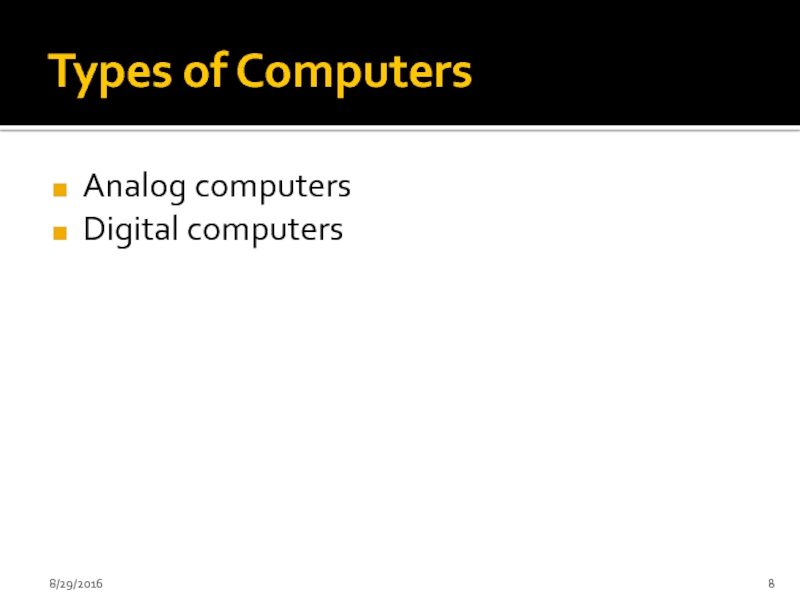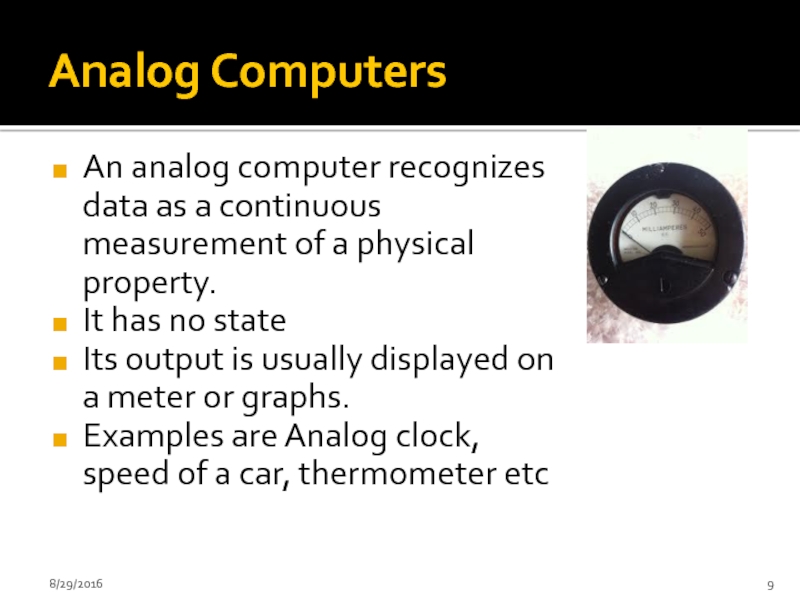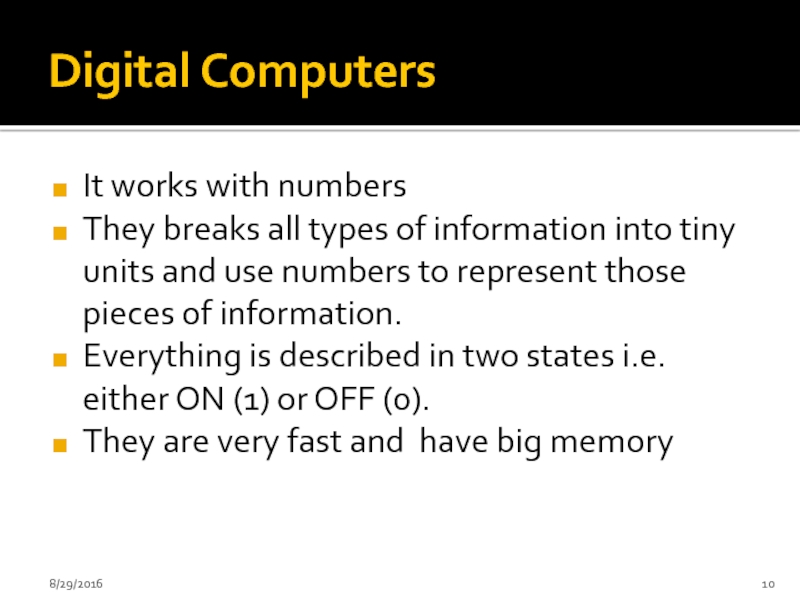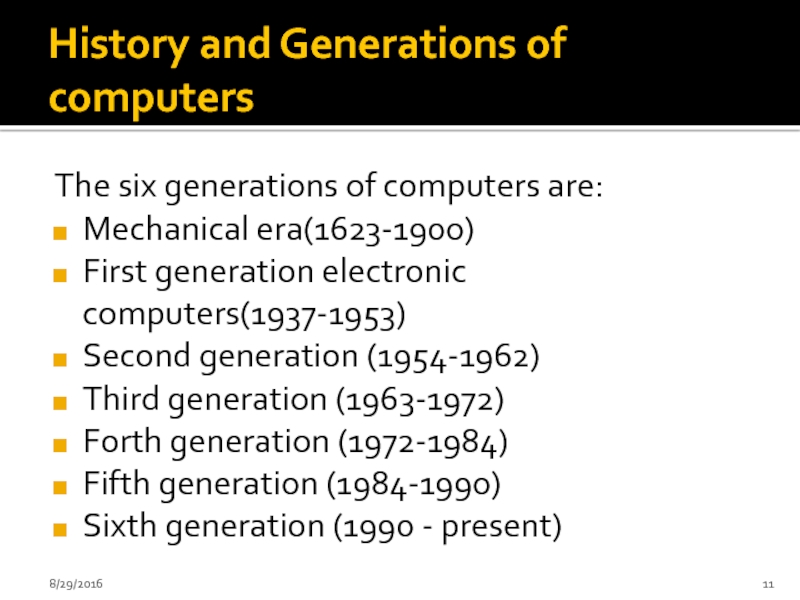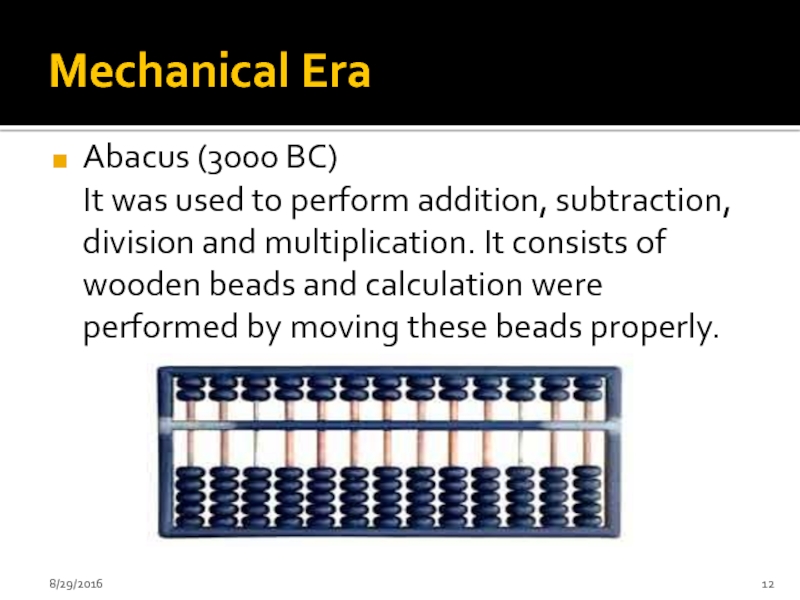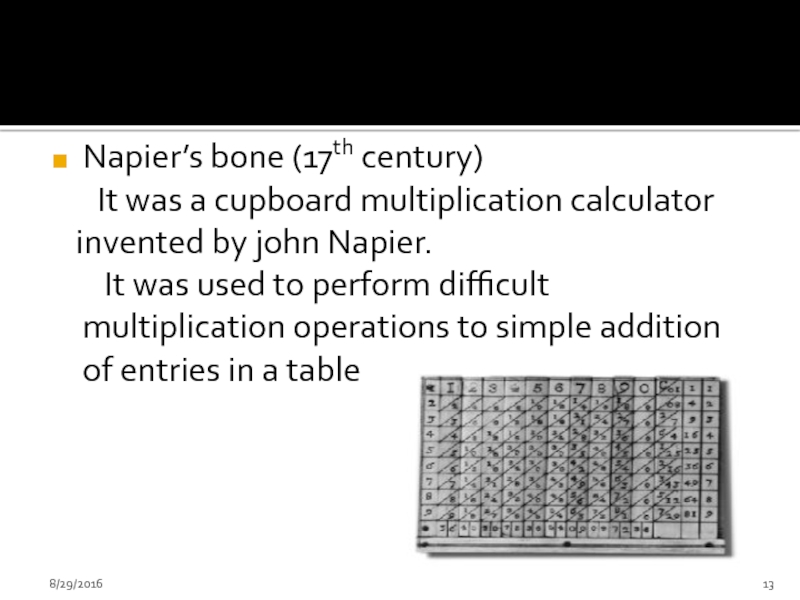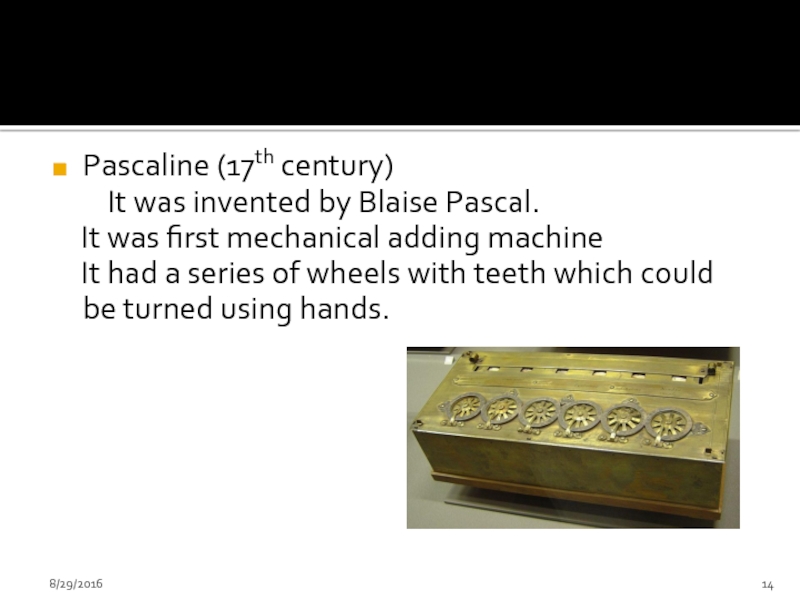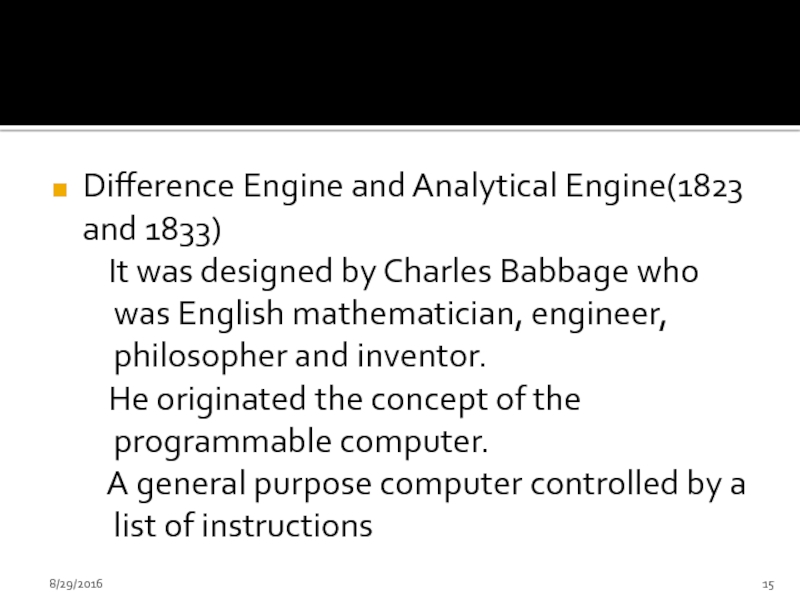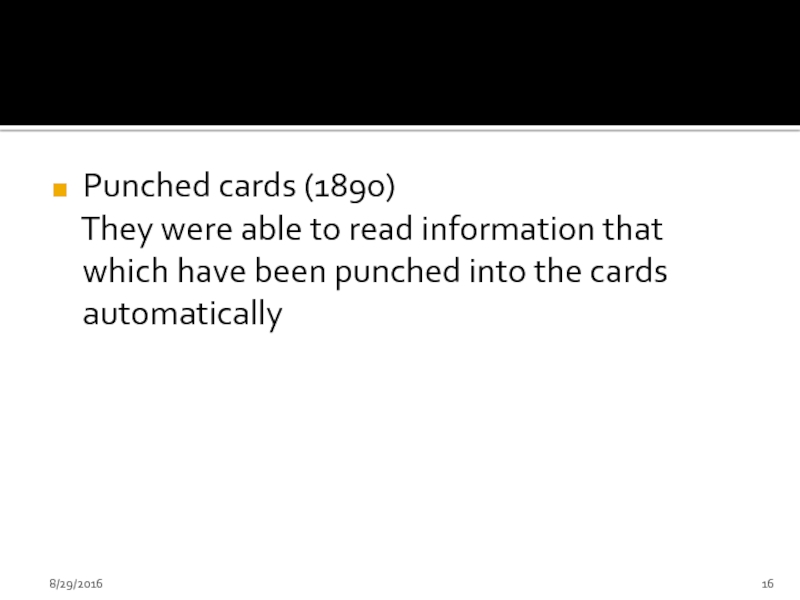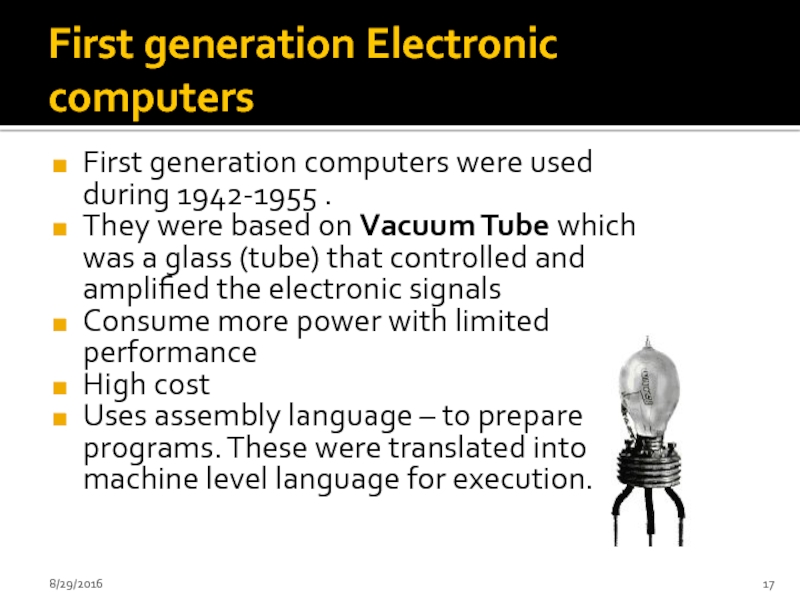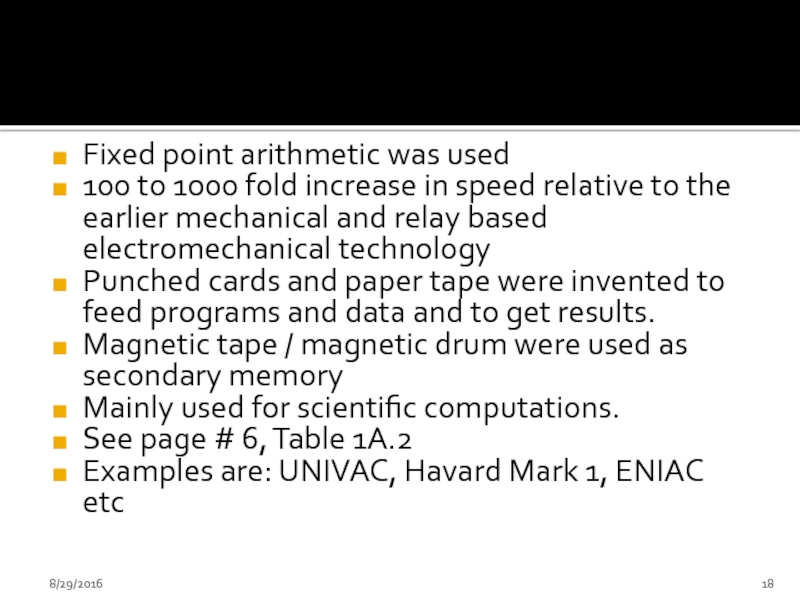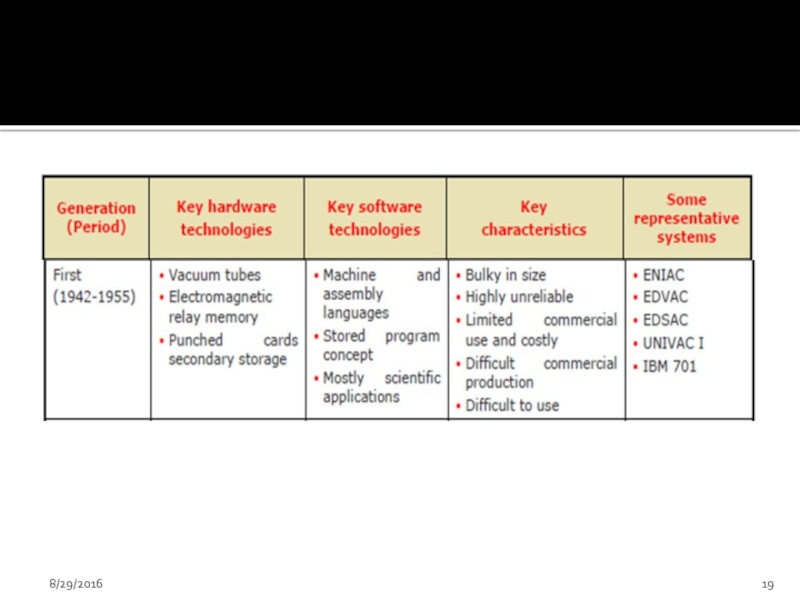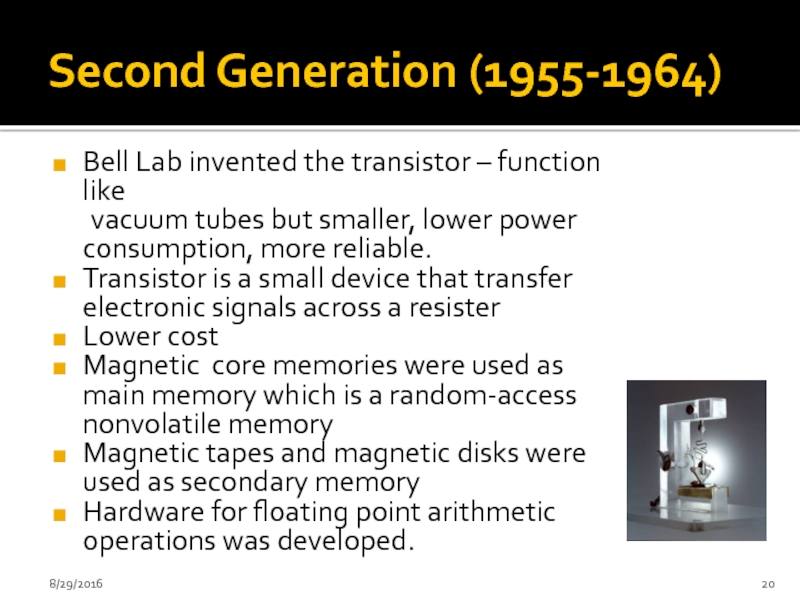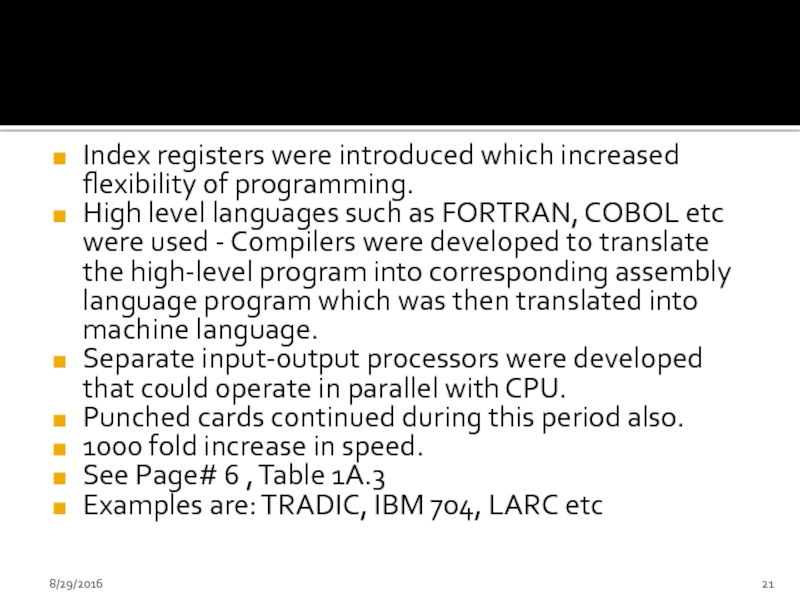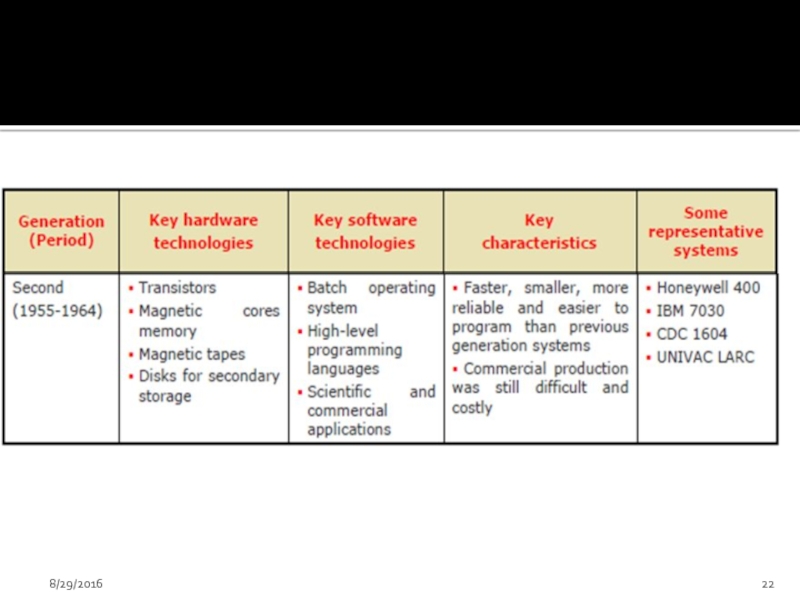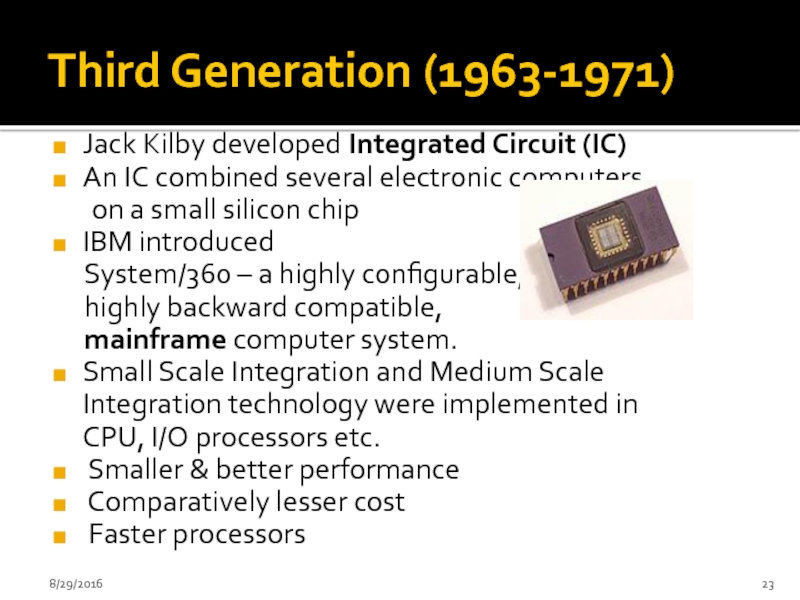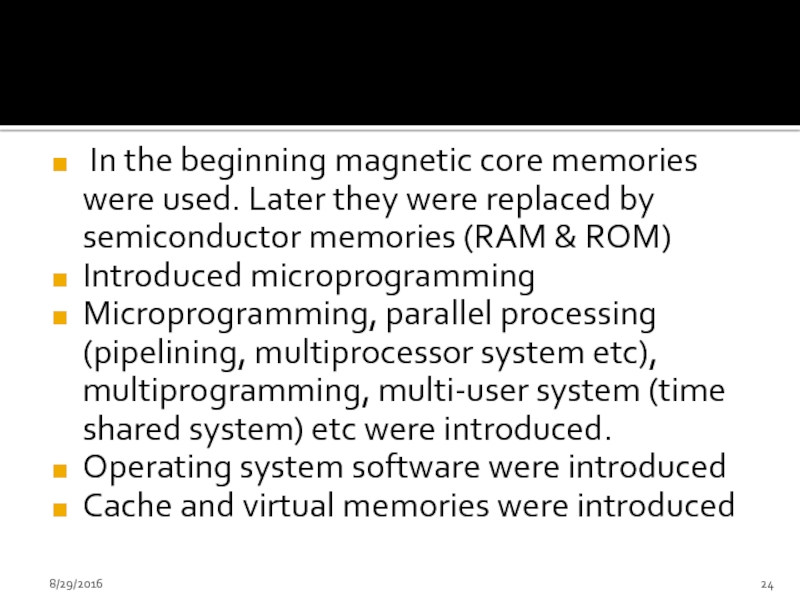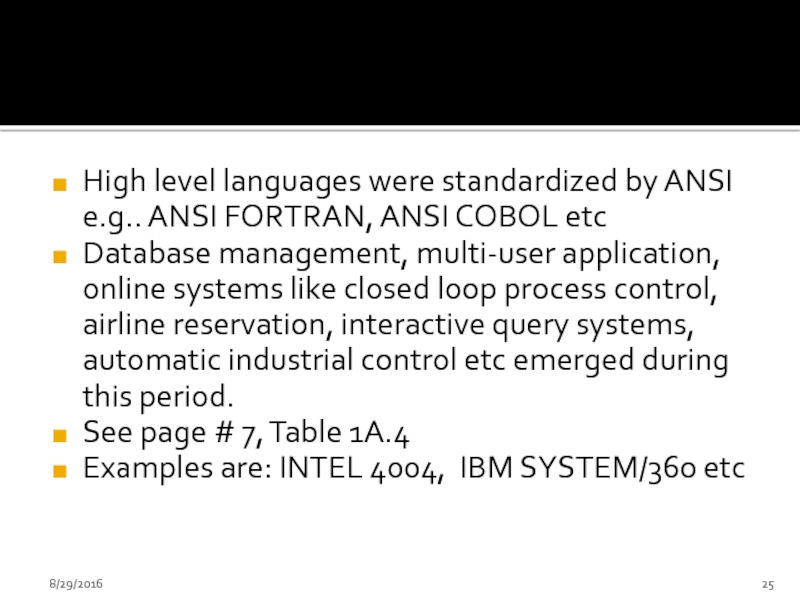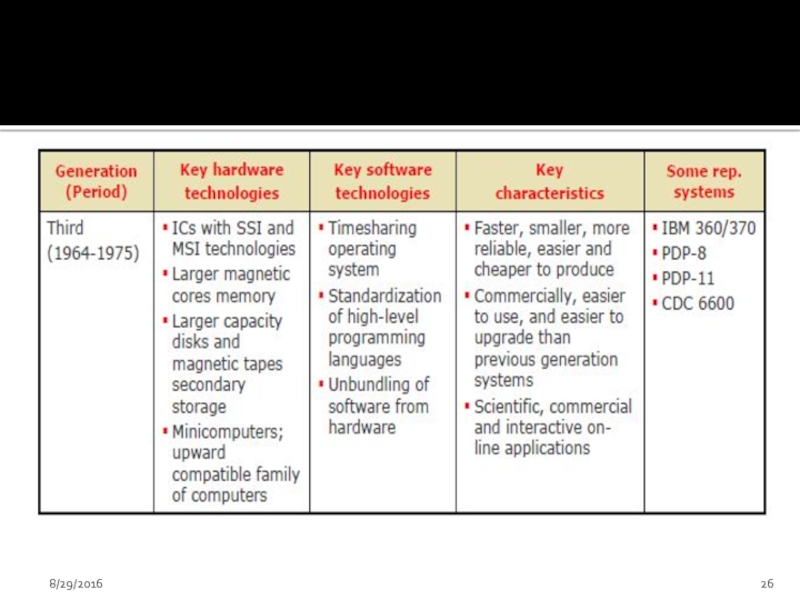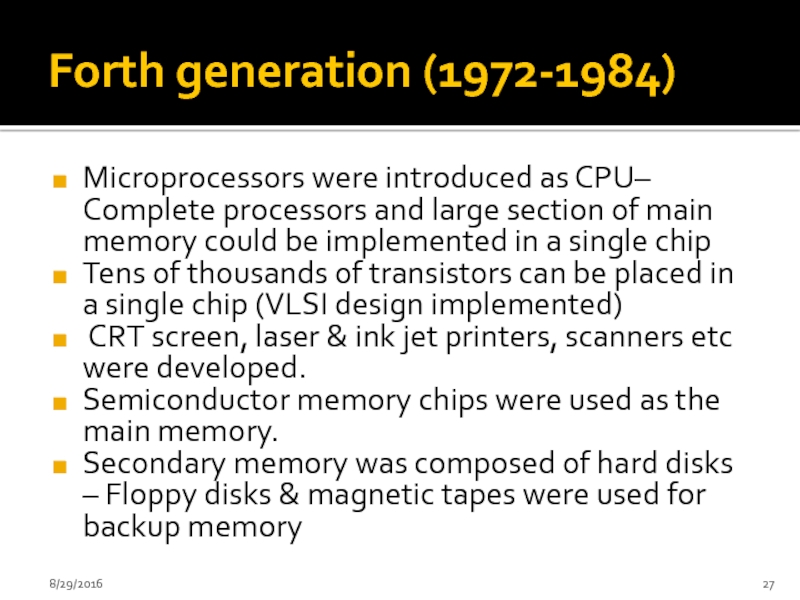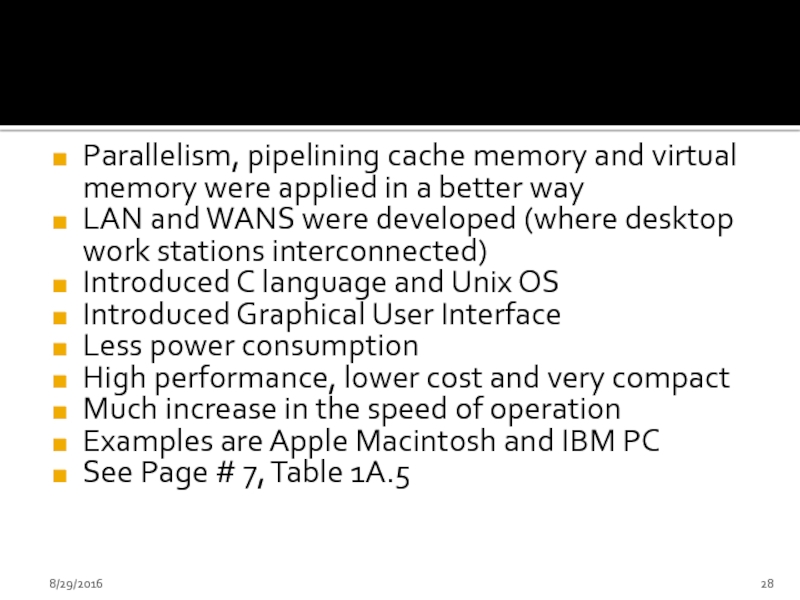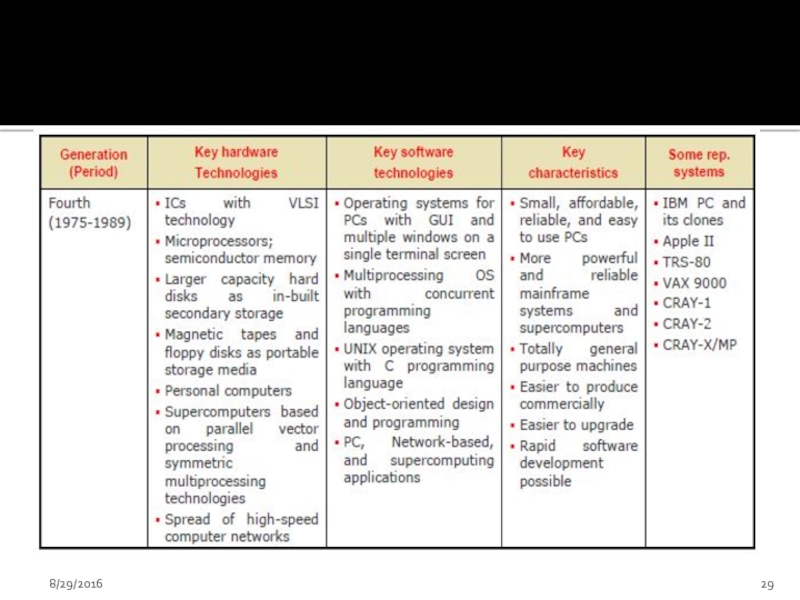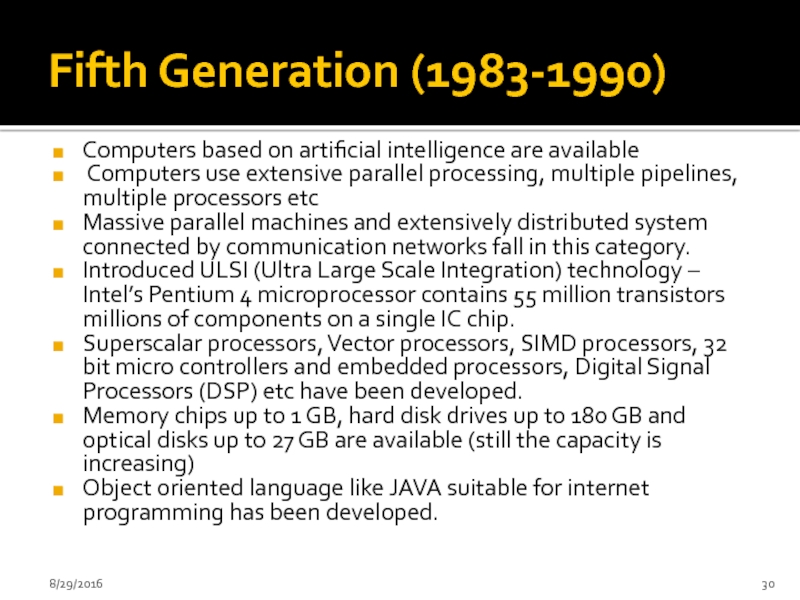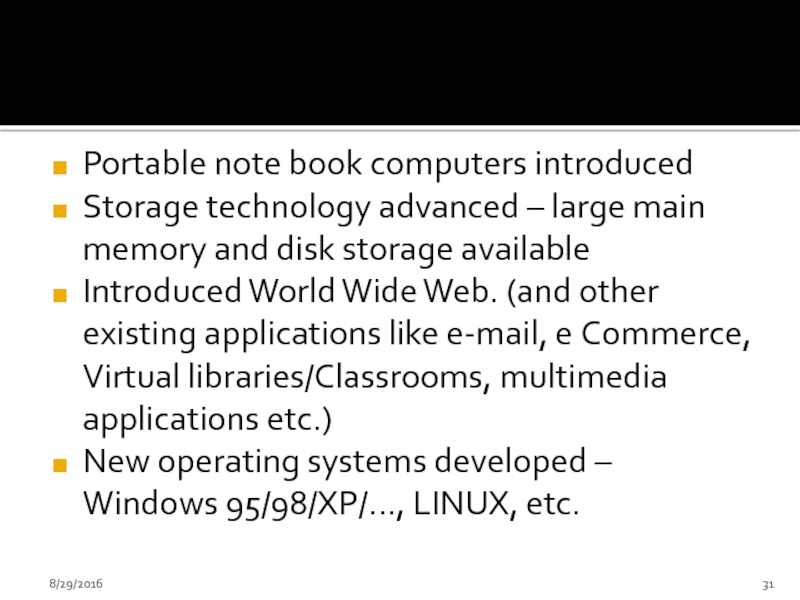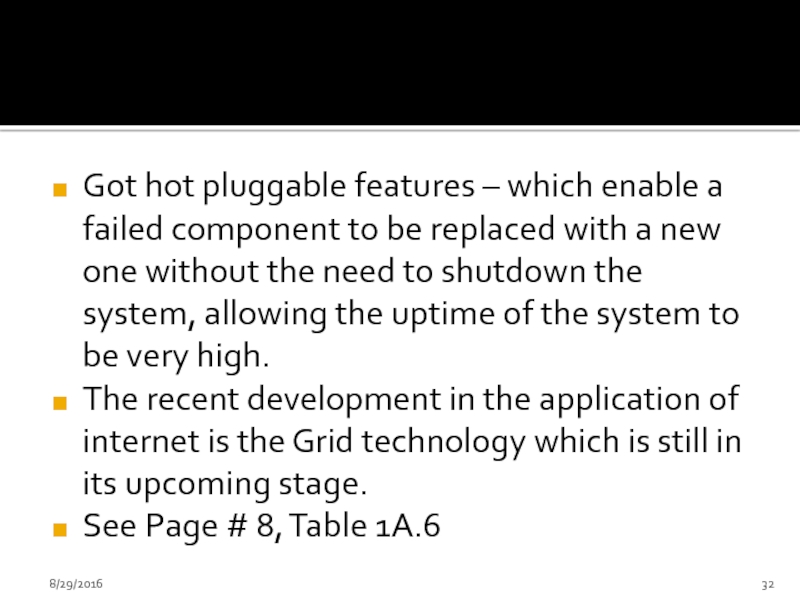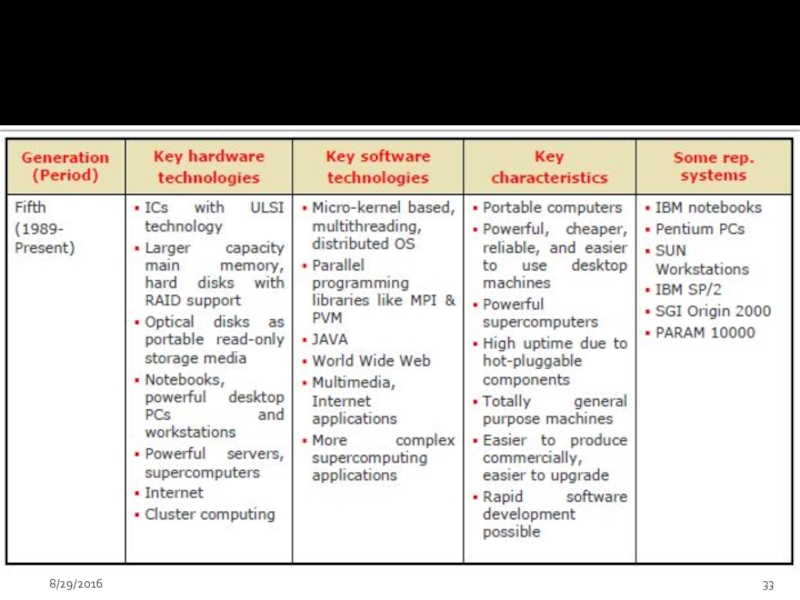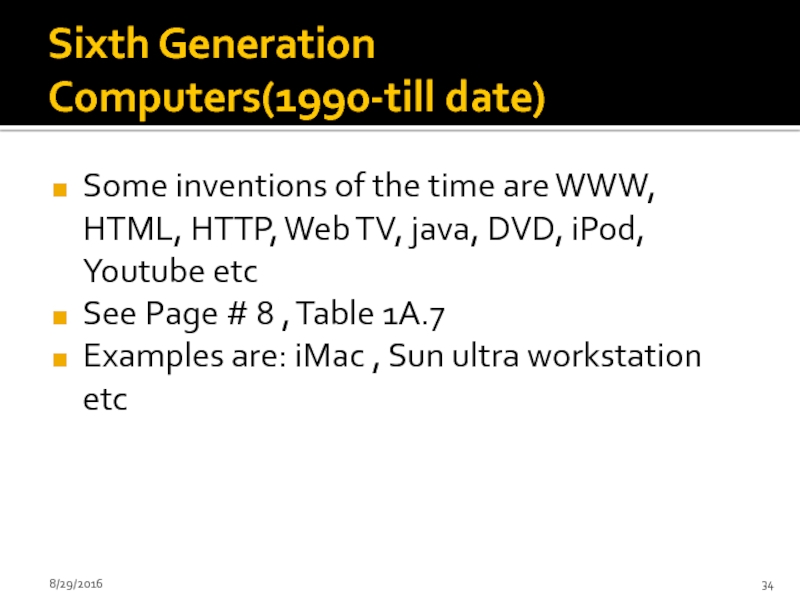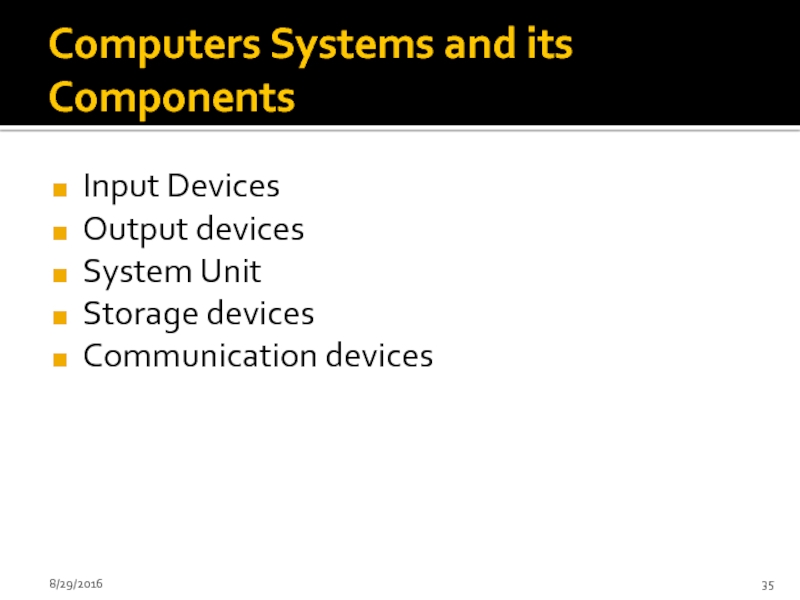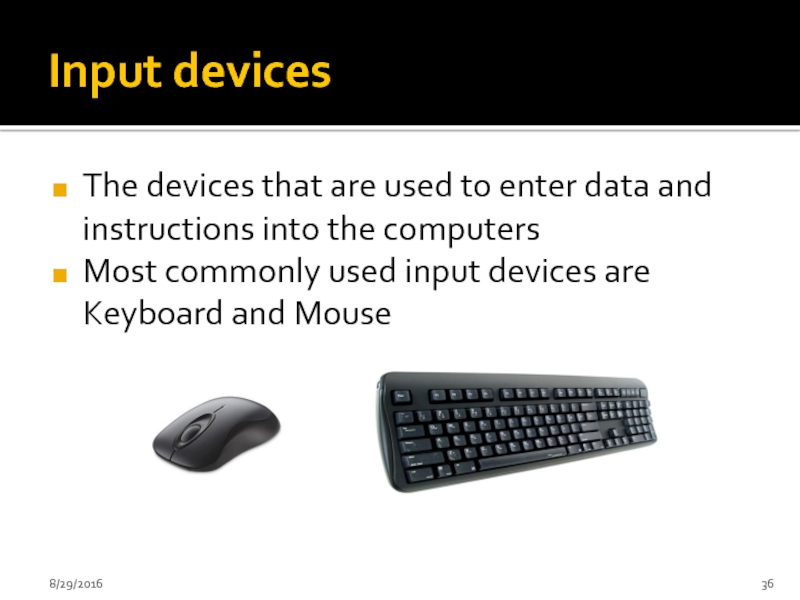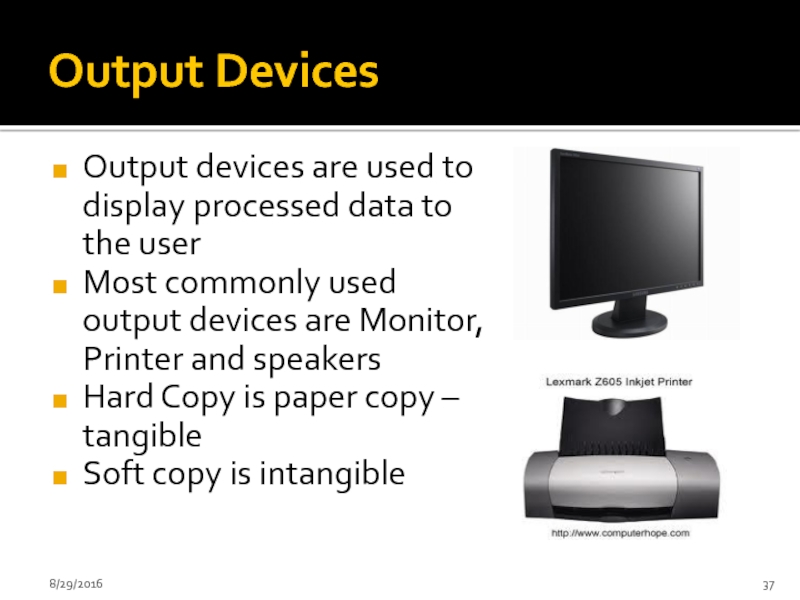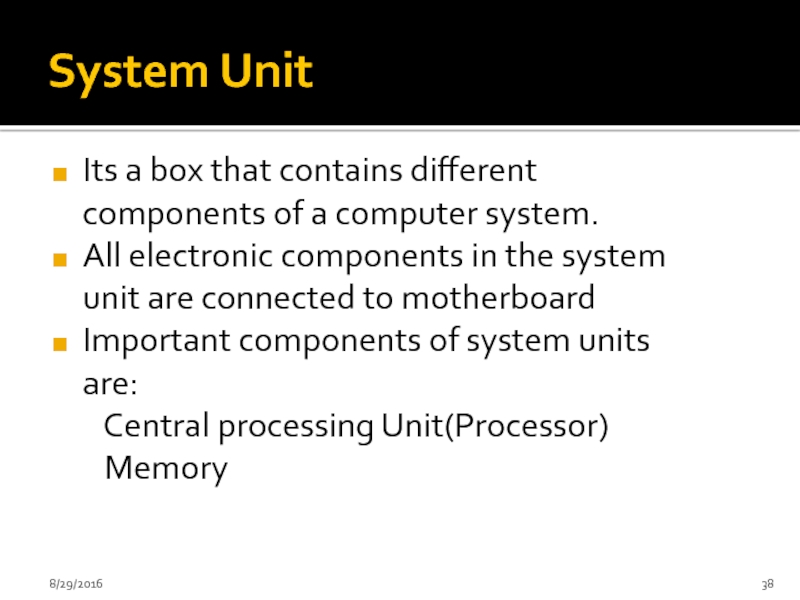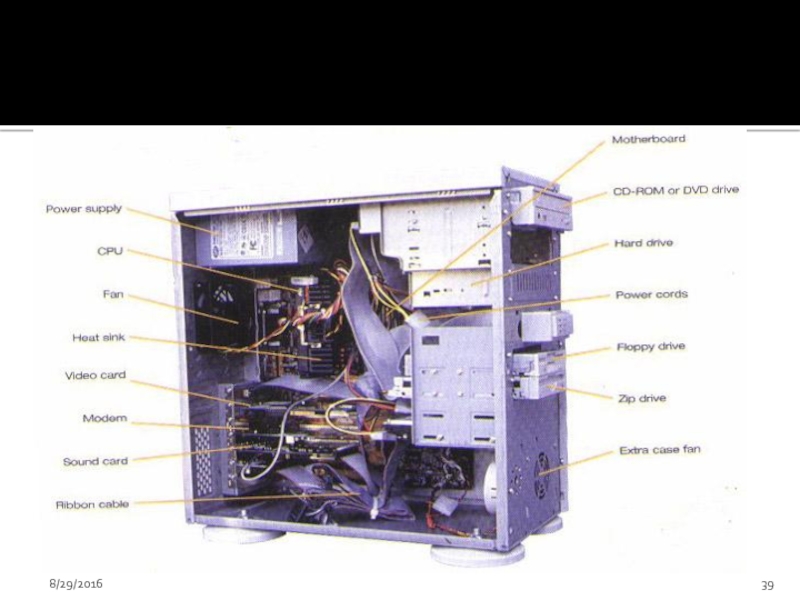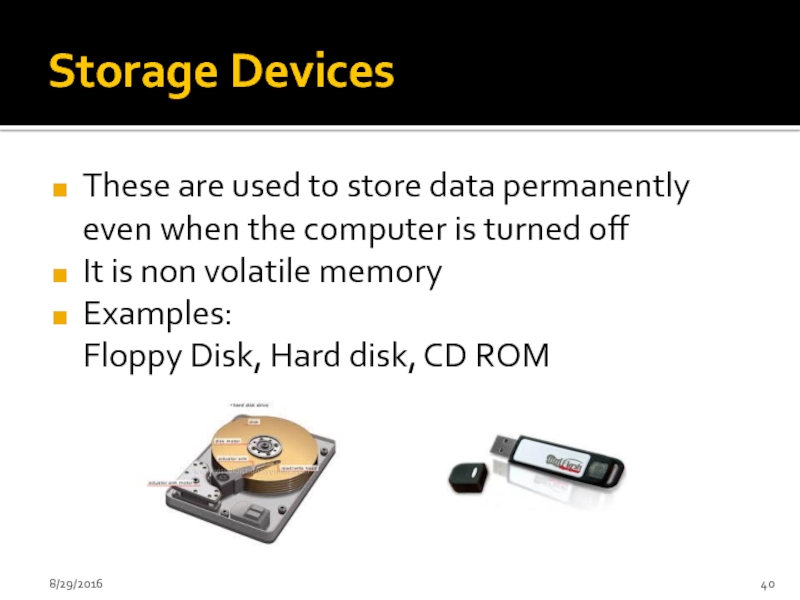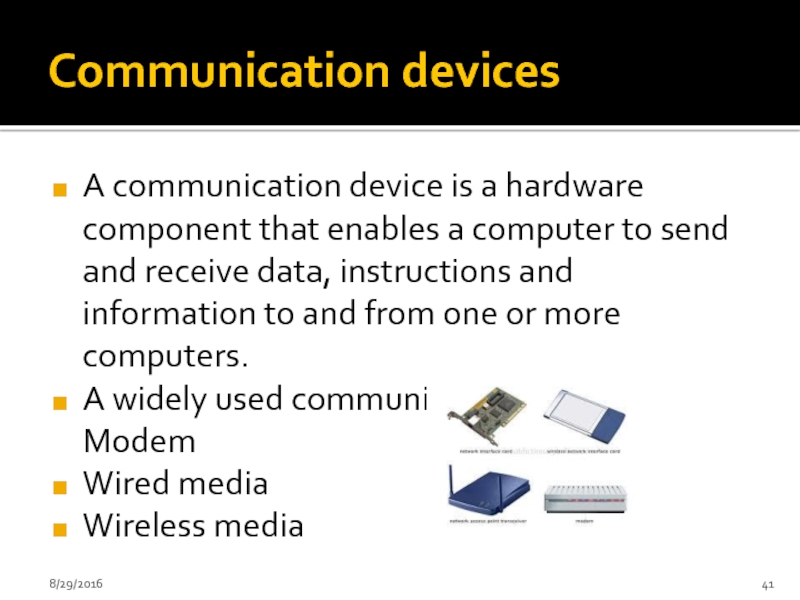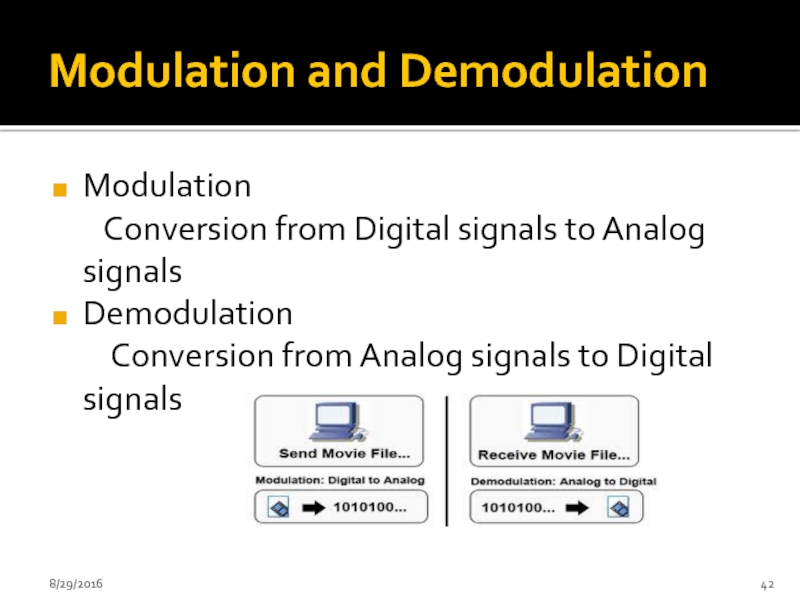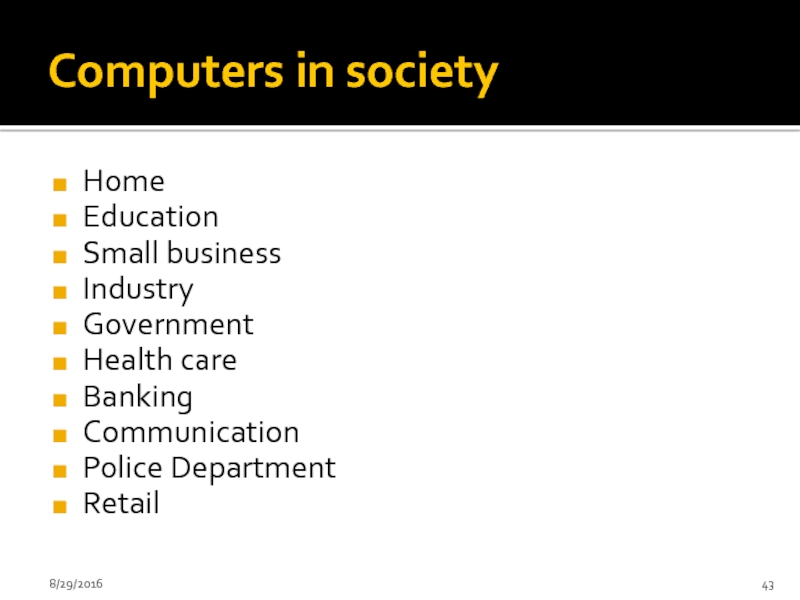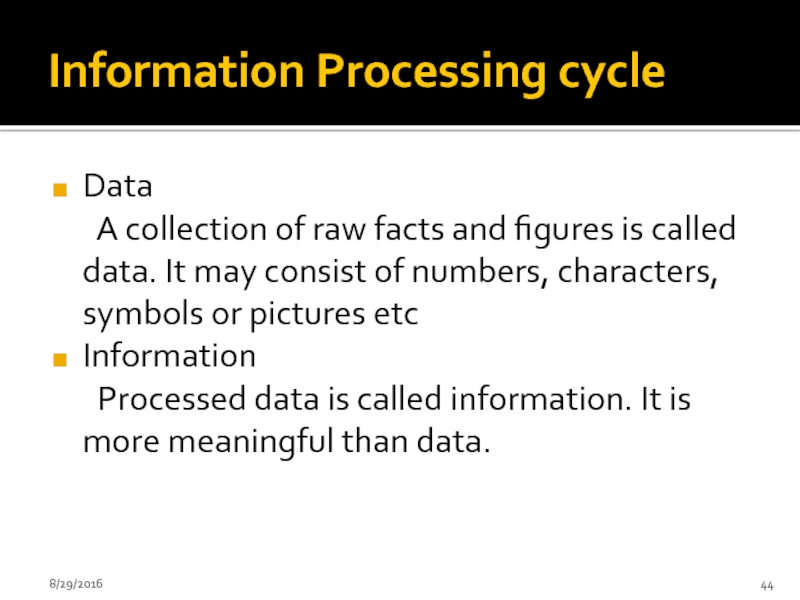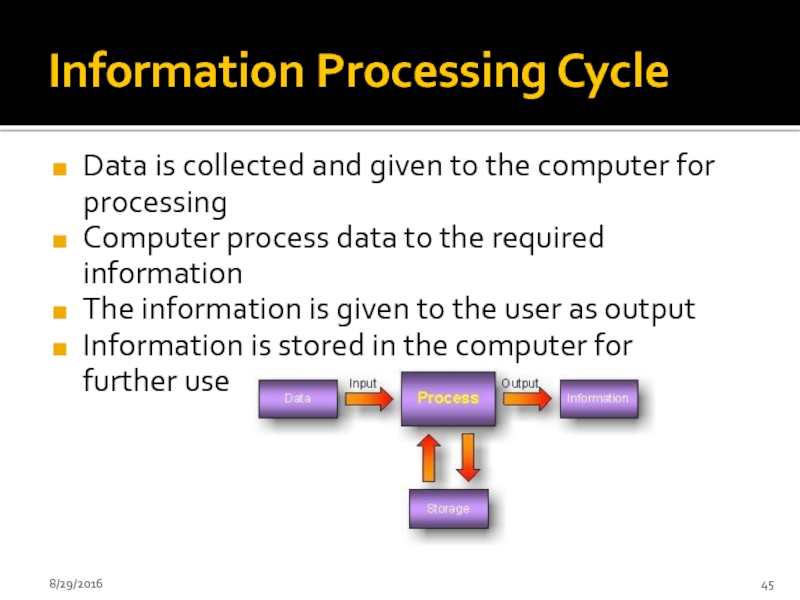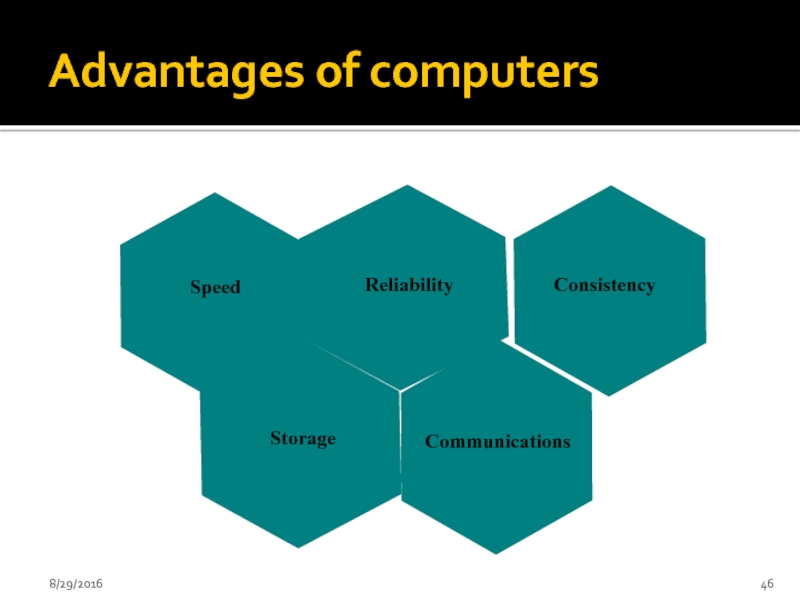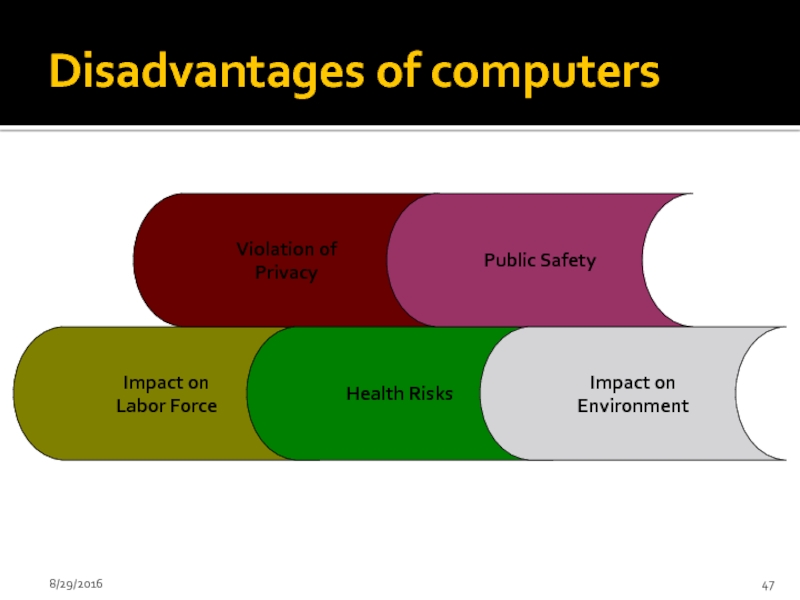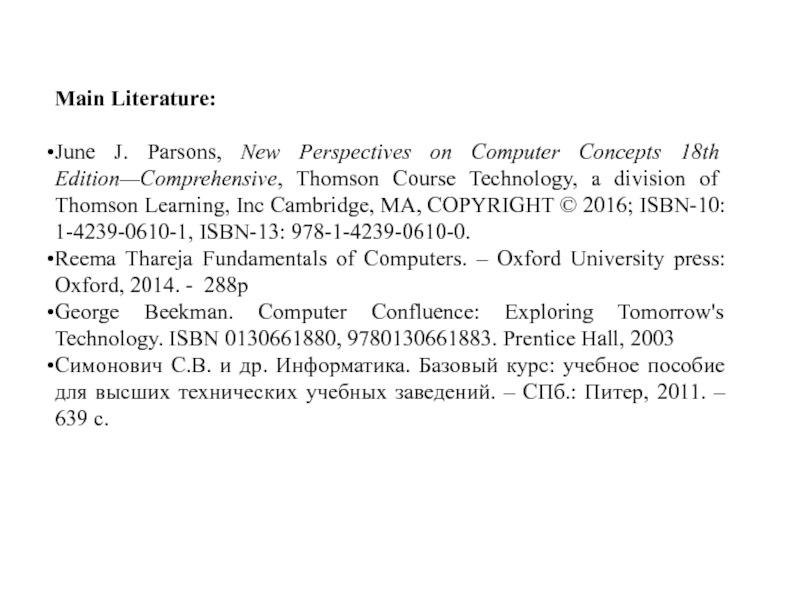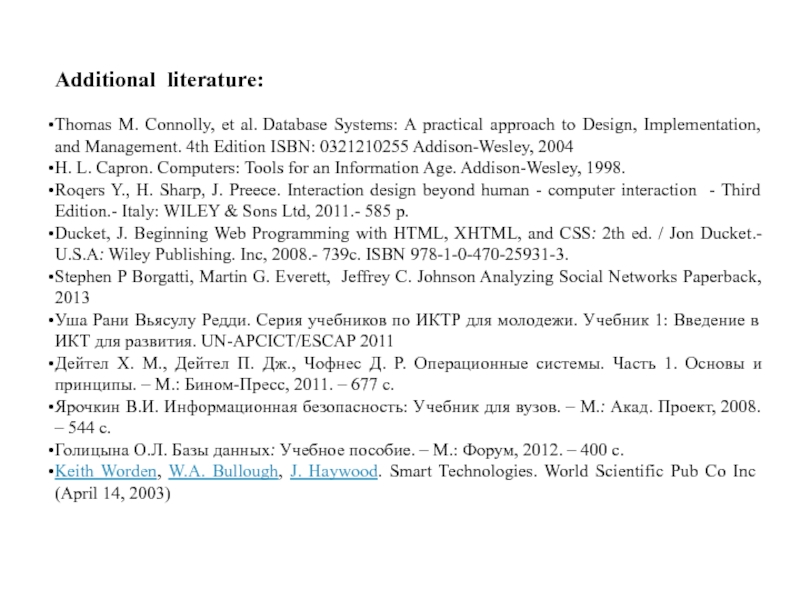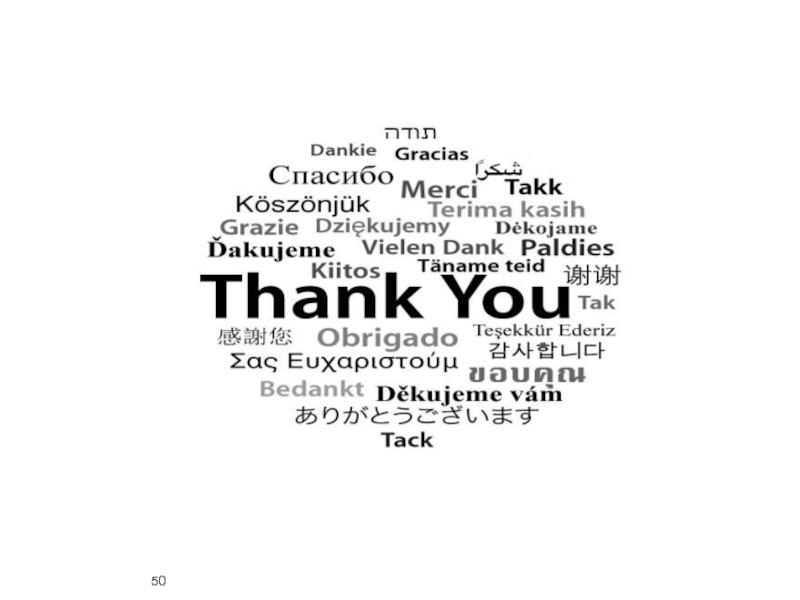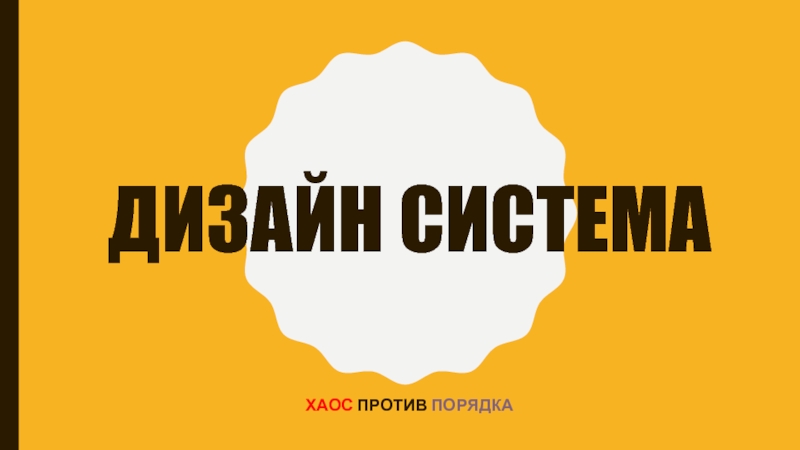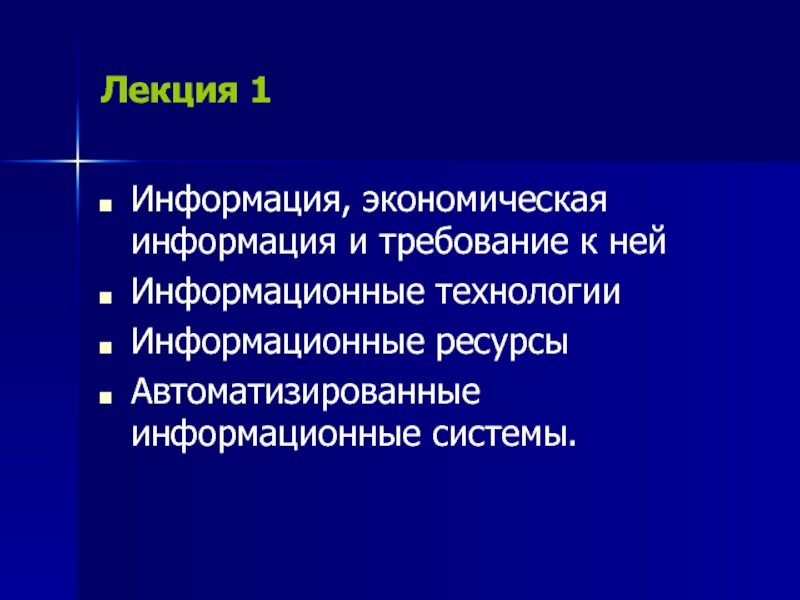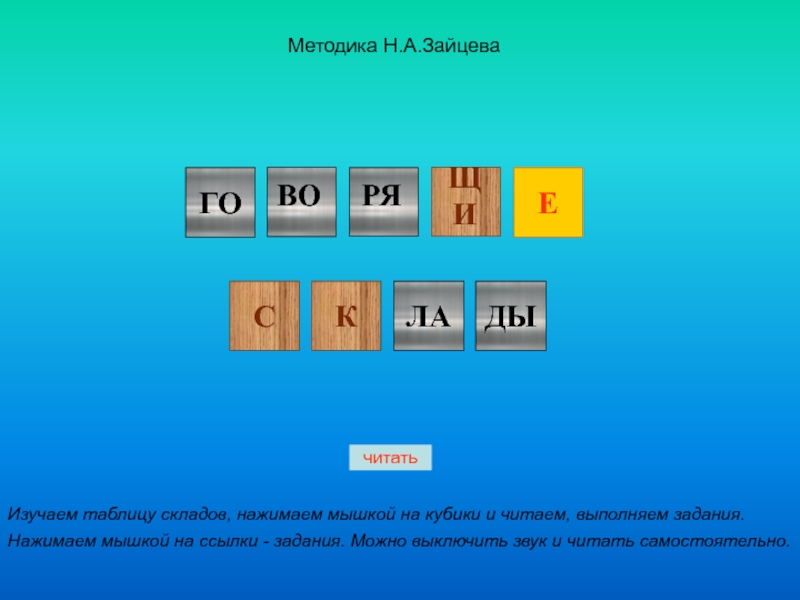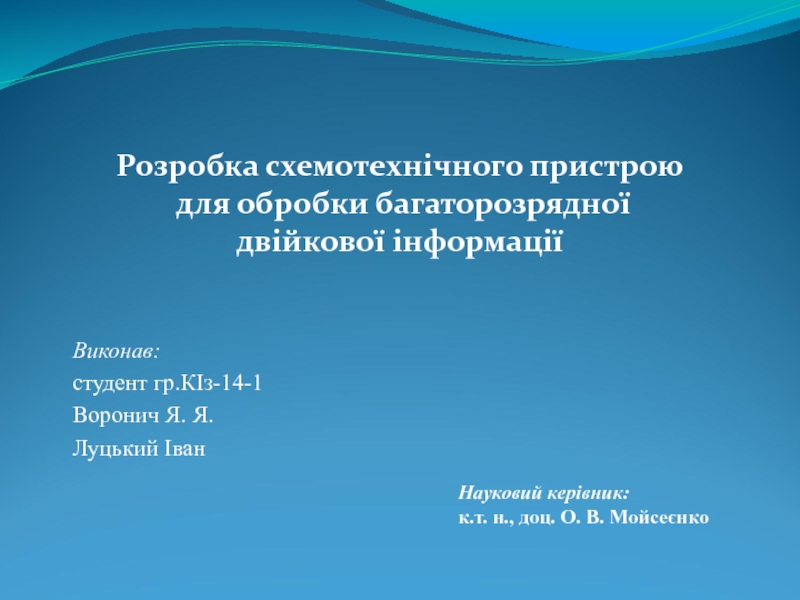- Главная
- Разное
- Дизайн
- Бизнес и предпринимательство
- Аналитика
- Образование
- Развлечения
- Красота и здоровье
- Финансы
- Государство
- Путешествия
- Спорт
- Недвижимость
- Армия
- Графика
- Культурология
- Еда и кулинария
- Лингвистика
- Английский язык
- Астрономия
- Алгебра
- Биология
- География
- Детские презентации
- Информатика
- История
- Литература
- Маркетинг
- Математика
- Медицина
- Менеджмент
- Музыка
- МХК
- Немецкий язык
- ОБЖ
- Обществознание
- Окружающий мир
- Педагогика
- Русский язык
- Технология
- Физика
- Философия
- Химия
- Шаблоны, картинки для презентаций
- Экология
- Экономика
- Юриспруденция
Introduction to Informational and Communication Technologies презентация
Содержание
- 1. Introduction to Informational and Communication Technologies
- 2. Information and communication technologies (ICT )
- 3. Thematic plan
- 4. Definition of Information Technology Information technology is
- 5. What is a Computer? An electronic device
- 6. 8/29/2016
- 7. Few Basics 8/29/2016
- 8. Types of Computers Analog computers Digital computers 8/29/2016
- 9. Analog Computers An analog computer recognizes data
- 10. Digital Computers It works with numbers They
- 11. History and Generations of computers The six
- 12. Mechanical Era Abacus (3000 BC)
- 13. Napier’s bone (17th century)
- 14. Pascaline (17th century)
- 15. Difference Engine and Analytical Engine(1823 and
- 16. Punched cards (1890) They
- 17. First generation Electronic computers First generation computers
- 18. Fixed point arithmetic was
- 19. 8/29/2016
- 20. Second Generation (1955-1964) Bell Lab invented the
- 21. Index registers were introduced which increased
- 22. 8/29/2016
- 23. Third Generation (1963-1971) Jack Kilby developed Integrated
- 24. In the beginning magnetic core
- 25. High level languages were standardized by
- 26. 8/29/2016
- 27. Forth generation (1972-1984) Microprocessors were introduced as
- 28. Parallelism, pipelining cache memory and virtual
- 29. 8/29/2016
- 30. Fifth Generation (1983-1990) Computers based on
- 31. Portable note book computers introduced
- 32. Got hot pluggable features – which
- 33. 8/29/2016
- 34. Sixth Generation Computers(1990-till date) Some inventions of
- 35. Computers Systems and its Components Input Devices
- 36. Input devices The devices that are used
- 37. Output Devices Output devices are used to
- 38. System Unit Its a box that contains
- 39. 8/29/2016
- 40. Storage Devices These are used to store
- 41. Communication devices A communication device is a
- 42. Modulation and Demodulation Modulation
- 43. Computers in society Home Education Small business
- 44. Information Processing cycle Data
- 45. Information Processing Cycle Data is collected and
- 46. Advantages of computers 8/29/2016
- 47. Disadvantages of computers 8/29/2016 Impact
- 48. Main Literature: June J. Parsons, New
- 49. Additional literature: Thomas M. Connolly, et
Слайд 2
Information and communication technologies (ICT ) is the discipline which considers
8/29/2016
Слайд 4Definition of Information Technology
Information technology is the technology that uses computing
Computer is a very important component of information technology
The world has become “global village” due to advancement in IT.
8/29/2016
Слайд 5What is a Computer?
An electronic device that is programmed to accept
Computer consists of hardware and software
Software is a set of instructions that tells a computer what to do
Hardware is the physical part of a computer E.g. CPU, RAM, HDD.etc
Relationship between hardware and software
8/29/2016
Слайд 9Analog Computers
An analog computer recognizes data as a continuous measurement of
It has no state
Its output is usually displayed on a meter or graphs.
Examples are Analog clock, speed of a car, thermometer etc
8/29/2016
Слайд 10Digital Computers
It works with numbers
They breaks all types of information into
Everything is described in two states i.e. either ON (1) or OFF (0).
They are very fast and have big memory
8/29/2016
Слайд 11History and Generations of computers
The six generations of computers are:
Mechanical era(1623-1900)
First
Second generation (1954-1962)
Third generation (1963-1972)
Forth generation (1972-1984)
Fifth generation (1984-1990)
Sixth generation (1990 - present)
8/29/2016
Слайд 12Mechanical Era
Abacus (3000 BC)
It was used to perform addition,
8/29/2016
Слайд 13
Napier’s bone (17th century)
It was a cupboard multiplication
invented by john Napier.
It was used to perform difficult multiplication operations to simple addition of entries in a table
8/29/2016
Слайд 14
Pascaline (17th century)
It was invented by Blaise
It was first mechanical adding machine
It had a series of wheels with teeth which could be turned using hands.
8/29/2016
Слайд 15
Difference Engine and Analytical Engine(1823 and 1833)
He originated the concept of the programmable computer.
A general purpose computer controlled by a list of instructions
8/29/2016
Слайд 16
Punched cards (1890)
They were able to read information that
8/29/2016
Слайд 17First generation Electronic computers
First generation computers were used during 1942-1955 .
They
Consume more power with limited performance
High cost
Uses assembly language – to prepare programs. These were translated into machine level language for execution.
8/29/2016
Слайд 18
Fixed point arithmetic was used
100 to 1000 fold increase
Punched cards and paper tape were invented to feed programs and data and to get results.
Magnetic tape / magnetic drum were used as secondary memory
Mainly used for scientific computations.
See page # 6, Table 1A.2
Examples are: UNIVAC, Havard Mark 1, ENIAC etc
8/29/2016
Слайд 20Second Generation (1955-1964)
Bell Lab invented the transistor – function like
Transistor is a small device that transfer electronic signals across a resister
Lower cost
Magnetic core memories were used as main memory which is a random-access nonvolatile memory
Magnetic tapes and magnetic disks were used as secondary memory
Hardware for floating point arithmetic operations was developed.
8/29/2016
Слайд 21
Index registers were introduced which increased flexibility of programming.
High level
Separate input-output processors were developed that could operate in parallel with CPU.
Punched cards continued during this period also.
1000 fold increase in speed.
See Page# 6 , Table 1A.3
Examples are: TRADIC, IBM 704, LARC etc
8/29/2016
Слайд 23Third Generation (1963-1971)
Jack Kilby developed Integrated Circuit (IC)
An IC combined several
on a small silicon chip
IBM introduced
System/360 – a highly configurable,
highly backward compatible,
mainframe computer system.
Small Scale Integration and Medium Scale Integration technology were implemented in CPU, I/O processors etc.
Smaller & better performance
Comparatively lesser cost
Faster processors
8/29/2016
Слайд 24
In the beginning magnetic core memories were used. Later they
Introduced microprogramming
Microprogramming, parallel processing (pipelining, multiprocessor system etc), multiprogramming, multi-user system (time shared system) etc were introduced.
Operating system software were introduced
Cache and virtual memories were introduced
8/29/2016
Слайд 25
High level languages were standardized by ANSI e.g.. ANSI FORTRAN, ANSI
Database management, multi-user application, online systems like closed loop process control, airline reservation, interactive query systems, automatic industrial control etc emerged during this period.
See page # 7, Table 1A.4
Examples are: INTEL 4004, IBM SYSTEM/360 etc
8/29/2016
Слайд 27Forth generation (1972-1984)
Microprocessors were introduced as CPU– Complete processors and large
Tens of thousands of transistors can be placed in a single chip (VLSI design implemented)
CRT screen, laser & ink jet printers, scanners etc were developed.
Semiconductor memory chips were used as the main memory.
Secondary memory was composed of hard disks – Floppy disks & magnetic tapes were used for backup memory
8/29/2016
Слайд 28
Parallelism, pipelining cache memory and virtual memory were applied in a
LAN and WANS were developed (where desktop work stations interconnected)
Introduced C language and Unix OS
Introduced Graphical User Interface
Less power consumption
High performance, lower cost and very compact
Much increase in the speed of operation
Examples are Apple Macintosh and IBM PC
See Page # 7, Table 1A.5
8/29/2016
Слайд 30Fifth Generation (1983-1990)
Computers based on artificial intelligence are available
Computers
Massive parallel machines and extensively distributed system connected by communication networks fall in this category.
Introduced ULSI (Ultra Large Scale Integration) technology – Intel’s Pentium 4 microprocessor contains 55 million transistors millions of components on a single IC chip.
Superscalar processors, Vector processors, SIMD processors, 32 bit micro controllers and embedded processors, Digital Signal Processors (DSP) etc have been developed.
Memory chips up to 1 GB, hard disk drives up to 180 GB and optical disks up to 27 GB are available (still the capacity is increasing)
Object oriented language like JAVA suitable for internet programming has been developed.
8/29/2016
Слайд 31
Portable note book computers introduced
Storage technology advanced – large main
Introduced World Wide Web. (and other existing applications like e-mail, e Commerce, Virtual libraries/Classrooms, multimedia applications etc.)
New operating systems developed – Windows 95/98/XP/…, LINUX, etc.
8/29/2016
Слайд 32
Got hot pluggable features – which enable a failed component to
The recent development in the application of internet is the Grid technology which is still in its upcoming stage.
See Page # 8, Table 1A.6
8/29/2016
Слайд 34Sixth Generation Computers(1990-till date)
Some inventions of the time are WWW, HTML,
See Page # 8 , Table 1A.7
Examples are: iMac , Sun ultra workstation etc
8/29/2016
Слайд 35Computers Systems and its Components
Input Devices
Output devices
System Unit
Storage devices
Communication devices
8/29/2016
Слайд 36Input devices
The devices that are used to enter data and instructions
Most commonly used input devices are Keyboard and Mouse
8/29/2016
Слайд 37Output Devices
Output devices are used to display processed data to the
Most commonly used output devices are Monitor, Printer and speakers
Hard Copy is paper copy – tangible
Soft copy is intangible
8/29/2016
Слайд 38System Unit
Its a box that contains different components of a computer
All electronic components in the system unit are connected to motherboard
Important components of system units are:
Central processing Unit(Processor)
Memory
8/29/2016
Слайд 40Storage Devices
These are used to store data permanently even when the
It is non volatile memory
Examples:
Floppy Disk, Hard disk, CD ROM
8/29/2016
Слайд 41Communication devices
A communication device is a hardware component that enables a
A widely used communication device is Modem
Wired media
Wireless media
8/29/2016
Слайд 42Modulation and Demodulation
Modulation
Conversion from Digital signals to
Demodulation
Conversion from Analog signals to Digital signals
8/29/2016
Слайд 43Computers in society
Home
Education
Small business
Industry
Government
Health care
Banking
Communication
Police Department
Retail
8/29/2016
Слайд 44Information Processing cycle
Data
A collection of raw facts and
Information
Processed data is called information. It is more meaningful than data.
8/29/2016
Слайд 45Information Processing Cycle
Data is collected and given to the computer for
Computer process data to the required information
The information is given to the user as output
Information is stored in the computer for further use
8/29/2016
Слайд 47Disadvantages of computers
8/29/2016
Impact on
Labor Force
Violation of
Privacy
Health Risks
Public Safety
Impact on
Environment
Слайд 48Main Literature:
June J. Parsons, New Perspectives on Computer Concepts 18th Edition—Comprehensive,
Reema Thareja Fundamentals of Computers. – Oxford University press: Oxford, 2014. - 288p
George Beekman. Computer Confluence: Exploring Tomorrow's Technology. ISBN 0130661880, 9780130661883. Prentice Hall, 2003
Симонович С.В. и др. Информатика. Базовый курс: учебное пособие для высших технических учебных заведений. – СПб.: Питер, 2011. – 639 с.
Слайд 49Additional literature:
Thomas M. Connolly, et al. Database Systems: A practical approach to
H. L. Capron. Computers: Tools for an Information Age. Addison-Wesley, 1998.
Roqers Y., H. Sharp, J. Preece. Interaction design beyond human - computer interaction - Third Edition.- Italy: WILEY & Sons Ltd, 2011.- 585 р.
Ducket, J. Beginning Web Programming with HTML, XHTML, and CSS: 2th ed. / Jon Ducket.- U.S.A: Wiley Publishing. Inc, 2008.- 739с. ISBN 978-1-0-470-25931-3.
Stephen P Borgatti, Martin G. Everett, Jeffrey C. Johnson Analyzing Social Networks Paperback, 2013
Уша Рани Вьясулу Редди. Серия учебников по ИКТР для молодежи. Учебник 1: Введение в ИКТ для развития. UN-APCICT/ESCAP 2011
Дейтел Х. М., Дейтел П. Дж., Чофнес Д. Р. Операционные системы. Часть 1. Основы и принципы. – М.: Бином-Пресс, 2011. – 677 c.
Ярочкин В.И. Информационная безопасность: Учебник для вузов. – М.: Акад. Проект, 2008. – 544 c.
Голицына О.Л. Базы данных: Учебное пособие. – М.: Форум, 2012. – 400 c.
Keith Worden, W.A. Bullough, J. Haywood. Smart Technologies. World Scientific Pub Co Inc (April 14, 2003)
